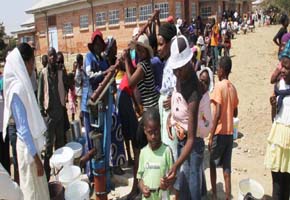Levy cloud seeding tax on farmers
Opinion Saul Gwakuba Ndlovu
WEATHER forecasts indicate that a large part of the Southern African region will receive below normal rainfall, which means, in effect, that it will face a drought. The region most likely to be hit by the adverse weather condition includes Matabeleland, the Midlands, Masvingo, the western part of Manicaland, some marginal parts of Mashonaland West and the south-eastern sectors of Mashonaland East.
Beyond Zimbabwe’s borders, the negative meteorological phenomenon will affect more or less the whole of Botswana, South Africa’s Limpopo Province, Zambia’s Western Province and parts of western Mozambique. If the drought occurs, as is most likely to happen, it will be one of numerous such unfortunate weather conditions to visit the region.
Zimbabwe has been a sovereign state for 35 years now. During that period we have attended one or two international conferences on desertification, an ecological climatic development said to be characterised by the extension of the Sahara Desert southwards at an annual average rate of one metre.
Zimbabwe is literally several thousands of kilometres (not just metres), south of the Sahara, the world’s largest desert. Meanwhile, we have had at least six droughts since we attained independence in 1980. Some of those foreseeable weather conditions have been quite devastating.
Droughts negatively affect Zimbabwe in that the country’s national economy is based largely on agriculture. The most badly affected regions are areas whose biggest urban centre is Bulawayo.
Much has been said about why Bulawayo’s industrial sector has been deserted, and why some of its factories have been turned into churches.
One of the causes of the desertion of the city by various industries has been identified as lack of water. Other urban centres such as Gweru have also had very adverse experiences because of droughts. We are living in a highly technological period when we can foretell what the weather will be seasons ahead. In like manner, we are virtually able to influence the rainy season in our favour by cloud seeding.
Australia relies on cloud seeding to keep large areas of its Northern Territory agriculturally alive. It also uses cloud seeding to keep its Great Sandy Desert agriculturally productive. The Rhodesian white settler regime used the technique to augment rainfall in parts of this country, particularly in Matabeleland.
If there has ever been an obvious need for cloud seeding in Zimbabwe, it is now, considering the havoc recurrent droughts have caused to the country’s socio-economic life since independence. Some people may be of the opinion that the technique would require a budgetary allocation. It might indeed require such funding, something that can be met through an affordable tax levied on the appropriate sector such as farmers.
It is most likely that most farmers would most happily support such a project. I have no doubt about that. Meanwhile, internationally Zimbabwe would be most strongly advised to help create and belong to a regional organisation whose sole aim is to look at ways and means of drought mitigation. Countries such as Botswana, Mozambique, South Africa, Namibia, Zambia, Angola, and Lesotho would greatly benefit from such an organisation.
The Sadc region can derive more benefit from exchanging information about regional weather and ecological conditions than attending conferences on desertification in the Sahel or South America. A regional climatic-ecological organisation could accelerate socio-economic integration as well as tame adverse meteorological threats in the Sadc area.
Such an organisation could closely analyse drought incidence in the immediate geographical region to see whether or not there is a more or less regular occurrence pattern. That could enable each nation to plan accordingly in terms of handling hostile weather conditions as well as developing properly adapted crops, food, beverages, livestock and even accommodation.
One of the objectives of such a regional body would be to identify and tame wild fruit trees some of whose fruits can either be canned or distilled into wines or other beverages. A coordinated scientific study of regional weather conditions can contribute a great deal to high agricultural and aqua cultural productivity.
Poverty alleviation, food production and industrialisation can be enhanced in the entire region by means of cloud seeding carried out by either a national government sponsored project or through the services of such a regional climatic organisation as already suggested.
Saul Gwakuba Ndlovu is a retired, Bulawayo – based journalist. He can be contacted on cell 0734 328 136 or through email. [email protected]







Comments